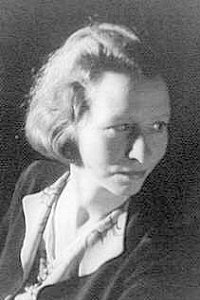|

Edna St. Vincent Millay (1892 - 1950)
Edna St. Vincent Millay, born in 1892 in Maine, grew to
become one of the premier twentieth-century lyric poets. She was also an accomplished
playwright and speaker who often toured giving readings of her poetry. All of that was in
her public life, but her private life was equally interesting. An unconventional childhood
led into an unconventional adulthood. She was an acknowledged bisexual who carried on many
affairs with women, an affection for which is sometimes evident in her poems and plays.
She did marry, but even that part of her life was somewhat unusual, with the marriage
being quite open, and extramarital affairs, though not documented, are quite probable.
At the young age of seven, Edna's mother asked her husband
to leave the family home. After that point he held a negligible role in the girl's life.
Edna and her two sisters moved, with their mother, to Newburyport, Massachusetts where, to
Edna's delight, she was given piano lessons. Edna (who insisted on being called Vincent
and who even entered writing contests under that name) and her sisters were encouraged in
their literary and musical leanings by their mother. Then, in highschool, Millay's
interests expanded to include theater. She performed in numerous plays and wrote a
Halloween play for her classmates to act out.
Millay enjoyed her free-spirited childhood and adolescence
and the creativity that it inspired. At the age of twenty, she entered her poem
"Renascence" into a poetry contest for the The Lyric Year, a contest from which
100 poems were to be chosen to be published. It was, at first, overlooked as being too
simplistic, however, one of the judges took a second look at it and the poem, now one of
her most well known, ended up winning fourth place. It was that poem which really started
her on her literary career, beginning with a scholarship to the then all female college of
Vassar.
Millay kept up her writing, both poetic and dramatic while
at Vassar. It was during this time that she was awarded the Pulitzer Prize for her book
The Harp-Weaver and other Poems. Also during her college career she broadened her sexual
horizons to include relationships with women. The most notable of these affairs was one
with the English actress Wynne Matthison. Matthison was not the only woman she was
involved with, though, and she kept in contact with some of them throughout her life.
Millay's first book of poetry, Renascence and Other Poems
was published in 1917 and well received. Then A Few Figs from Thistles was published in
1922 and sparked some attention as well as controversy with its feminist leanings. In
particular the poems within maintained that the sexual freedom formerly commandeered by men
was equally valid for women. This feeling is particularly obvious in the sonnet beginning
"What lips my lips have kissed,".
Keep in mind that all of this was accomplished during
Millay's college years! After graduation the woman moved to Greenwich Village in New York,
a particularly free-thinking and artistic borough. She kept up her writing as well as her
involvements with women, but also began to take men as lovers though it would seem that none
of them were able to "sway" her from her natural lesbian leanings. The following
paragraph is quoted from another web page dedicated to Edna St. Vincent Millay, which is located at Sappho.com.
In Great Companions, Max Eastman relates an interesting
story about Millay that, if true, reveals something of her attitude about own sexuality.
According to Eastman, while at a cocktail party Millay discussed her recurrent headaches
with a psychologist. He asked her, "I wonder if it has ever occurred to you that you
might perhaps, although you are hardly conscious of it, have an occasional impulse toward
a person of your own sex?" She responded, "Oh, you mean I'm homosexual! Of
course I am, and heterosexual, too, but what's that got to do with my headache?"
Millay did eventually marry Eugen Boissevain, who managed
her career and was a great source of support. The marriage, as mentioned above, was agreed
to be open and Millay herself said that they maintained their personal freedom, living
more as great friends than as husband and wife. Millay, a smoker in an age of smokers,
succumbed to her failure in 1950 at her home, Steepletop, in Austerlitz New York.
Boissevain, who was considerably older, had died the previous year.
|
